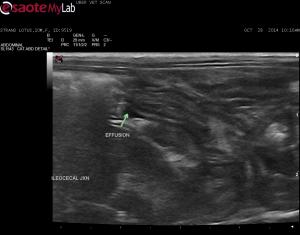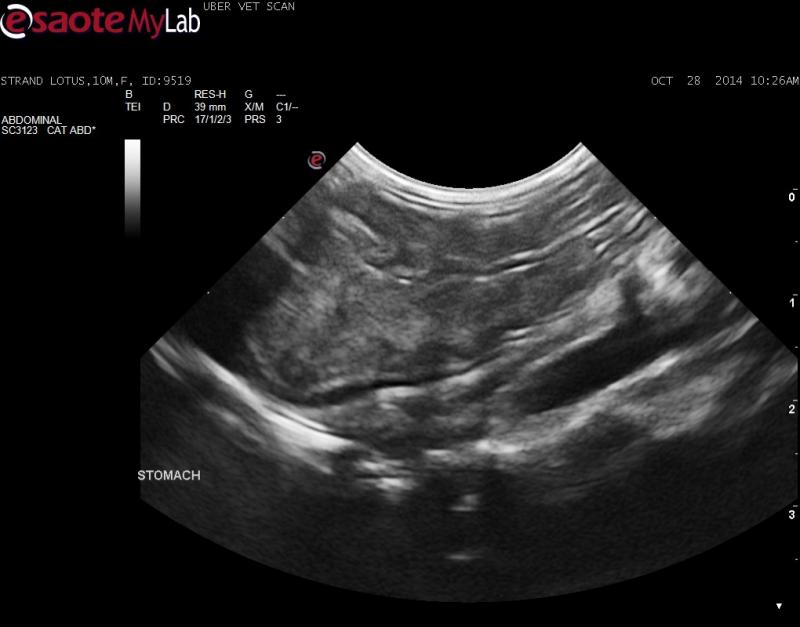– 10 month old FS Sphynx feline on and off history of vomiting, decreased appetite and wt loss
– neutrophilia on bloodwork otherwise viral testing NEG, biochem unremarkable
– rDVM placed pet on Clavamox with no improvement
– no history of fever
u/s thickened stomach wall, trace abdominal effusion and enlarged jejunal LN’s
DDx: IBD/gastritis, FIP, lymphoma
Any other thoughts – proceed with LN FNA?
– 10 month old FS Sphynx feline on and off history of vomiting, decreased appetite and wt loss
– neutrophilia on bloodwork otherwise viral testing NEG, biochem unremarkable
– rDVM placed pet on Clavamox with no improvement
– no history of fever
u/s thickened stomach wall, trace abdominal effusion and enlarged jejunal LN’s
DDx: IBD/gastritis, FIP, lymphoma
Any other thoughts – proceed with LN FNA?



20 responses to “Vomiting young cat”
Ah yes the ropey bowel
Ah yes the ropey bowel cat wiht mesenteric lymphadenopathy.
DDX parasites, IBD, FIP and maybe emerging LSA or MCT less likely because the LN are still egg shaped and echogenic as opposed to hypoechoic and distorted. This is a tendency and not an absolute by the way.
FNA first and consider PCR or PARR for lsa if lymphoid population is the dx on cytology
Given the history FIP is very possible here but may need full thickness and intraoperative ultrasound best to delineate the worst lesions for the dx.
Ah yes the ropey bowel
Ah yes the ropey bowel cat wiht mesenteric lymphadenopathy.
DDX parasites, IBD, FIP and maybe emerging LSA or MCT less likely because the LN are still egg shaped and echogenic as opposed to hypoechoic and distorted. This is a tendency and not an absolute by the way.
FNA first and consider PCR or PARR for lsa if lymphoid population is the dx on cytology
Given the history FIP is very possible here but may need full thickness and intraoperative ultrasound best to delineate the worst lesions for the dx.
How thick were the bowel
How thick were the bowel walls? Any muscularis thickening or bowel layer disproportionate thickening?
How thick were the bowel
How thick were the bowel walls? Any muscularis thickening or bowel layer disproportionate thickening?
Hi Marty
The bowel wall
Hi Marty
The bowel wall thickness (SI) was normal and the layering was normal as well with no submucosal or muscularis thickening. That being said, the peristalsis seemed somewhat “stiff” to me in the jejunum. The stomach was the only part that was otherwise grossly abnormal on ultrasound.
I am hoping to hear from the owner in order to recheck and perform a LN FNA. He is a VERY cautious pet owner. I also recommended chest rads but he did not want to do it because of the radiation. Doing an FNA on his pet will be a big deal -so we will see : )
Hi Marty
The bowel wall
Hi Marty
The bowel wall thickness (SI) was normal and the layering was normal as well with no submucosal or muscularis thickening. That being said, the peristalsis seemed somewhat “stiff” to me in the jejunum. The stomach was the only part that was otherwise grossly abnormal on ultrasound.
I am hoping to hear from the owner in order to recheck and perform a LN FNA. He is a VERY cautious pet owner. I also recommended chest rads but he did not want to do it because of the radiation. Doing an FNA on his pet will be a big deal -so we will see : )
Do u have actual bowel
Do u have actual bowel measurements?
Do u have actual bowel
Do u have actual bowel measurements?
Duodenum 0.25cm
Jejunum
Duodenum 0.25cm
Jejunum 0.23cm
Colon 0.09 cm
Stomach – up to 1.64cm at its thickest
Duodenum 0.25cm
Jejunum
Duodenum 0.25cm
Jejunum 0.23cm
Colon 0.09 cm
Stomach – up to 1.64cm at its thickest
Just wanted to make sure we
Just wanted to make sure we were all on the same page with wall thicknesses.
Just wanted to make sure we
Just wanted to make sure we were all on the same page with wall thicknesses.
No worries! I use Marc
No worries! I use Marc D’Anjou’s book for reference ranges and have the normals in my Timeless system for easy reference when making my reports
No worries! I use Marc
No worries! I use Marc D’Anjou’s book for reference ranges and have the normals in my Timeless system for easy reference when making my reports
IN my experience its not the
IN my experience its not the bowel thickness in cats thats important unless detail loss in a certain region but the thickness of the individual layers and inversion of the muscularis/mucosal ratio. You can have at times dramatic ratio changes and normal wall thicknesses. What this all means nobody knows lol but an item iof current studies.
IN my experience its not the
IN my experience its not the bowel thickness in cats thats important unless detail loss in a certain region but the thickness of the individual layers and inversion of the muscularis/mucosal ratio. You can have at times dramatic ratio changes and normal wall thicknesses. What this all means nobody knows lol but an item iof current studies.
I agree, I have seen this as
I agree, I have seen this as well where muscularis is quite thick but overall thickness considered to be wnl
I agree, I have seen this as
I agree, I have seen this as well where muscularis is quite thick but overall thickness considered to be wnl
I wholeheartedly
I wholeheartedly agree…overall thickness is not as important as proportionality of layering and when the muscularis gets thick (regardless of overall wall thickness), it’s significant – suggesting IBD vs. SC-LSA. In most cases with muscularis changes the wall thickness is above 2.8mm which is when I call thickness abnormal. 2.2-2.5 is what I call normal, 2.5-2.8 becomes gray zone. But I’ve seen cats with normally proportioned bowel layering that is 2.6-2.8 and I don’t get too excited.
I wholeheartedly
I wholeheartedly agree…overall thickness is not as important as proportionality of layering and when the muscularis gets thick (regardless of overall wall thickness), it’s significant – suggesting IBD vs. SC-LSA. In most cases with muscularis changes the wall thickness is above 2.8mm which is when I call thickness abnormal. 2.2-2.5 is what I call normal, 2.5-2.8 becomes gray zone. But I’ve seen cats with normally proportioned bowel layering that is 2.6-2.8 and I don’t get too excited.